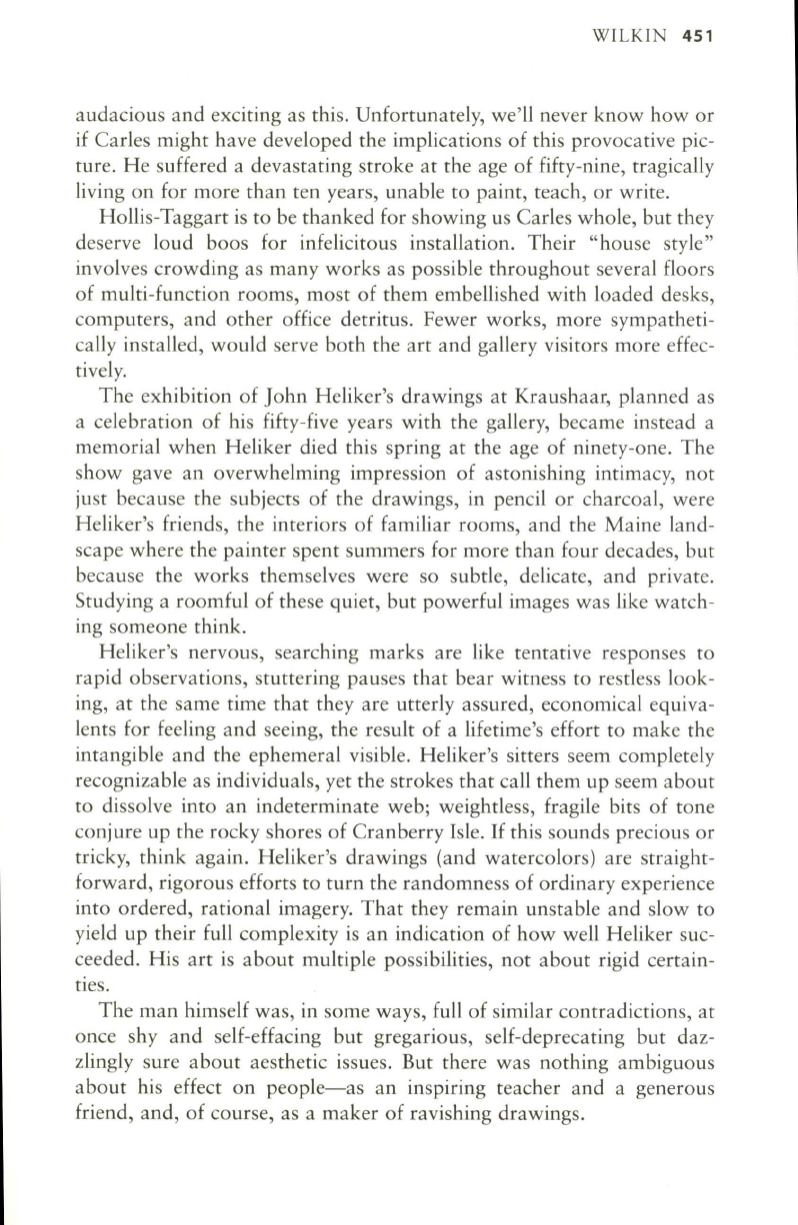
WILKIN
451
audacious and exciting as this. Unfortunately, we'll never know how or
if Carles might have developed the implications of this provocative pic–
ture. He suffered a devastating stroke at the age of fifty-nine, tragically
living on for more than ten years, unable to paint, teach, or write.
Hollis-Taggart is to be thanked for showing us Carles whole, but they
deserve loud boos for infelicitous installation. Their "house style"
involves crowding as many works as possible throughout several floors
of multi-function rooms, most of them embellished with loaded desks,
computers, and other office detritus. Fewer works, more sympatheti–
cally installed, would serve both the art and gallery visitors more effec–
tively.
The exhibition of John Heliker's drawings at Kraushaar, planned as
a celebration of his fifty-five years with the gallery, became instead a
memorial when Heliker died this spring at the age of ninety-one. The
show gave an overwhelming impression of astonishing intimacy, not
just because the subjects of the drawings, in pencil or charcoal, were
Heliker's friends, the interiors of familiar rooms, and the Maine land–
scape where the painter spent summers for more than four decades, but
because the works themselves were so subtle, delicate, and private.
Studying a roomful of these quiet, but powerful images was like watch–
ing someone think.
Heliker's nervous, searching marks are like tentative responses to
rapid observations, stuttering pauses that bear witness to restless look–
ing, at the same time that they are utterly assured, economical equiva–
lents for feeling and seeing, the result of a lifetime's effort to make the
intangible and the ephemeral visible. Heliker's sitters seem completely
recognizable as individuals, yet the strokes that call them up seem about
to dissolve into an indeterminate web; weightless, fragile bits of tone
conjure up the rocky shores of Cranberry Isle.
If
this sounds precious or
tricky, think again. Heliker's drawings (and watercolors) are straight–
forward, rigorous efforts to turn the randomness of ordinary experience
into ordered, rational imagery. That they remain unstable and slow to
yield up their full complexity is an indication of how well Heliker suc–
ceeded. His art is about multiple possibilities, not about rigid certain–
ties.
The man himself was, in some ways, full of similar contradictions, at
once shy and self-effacing but gregarious, self-deprecating but daz–
zlingly sure about aesthetic issues. But there was nothing ambiguous
about his effect on people-as an inspiring teacher and a generous
friend, and, of course, as a maker of ravishing drawings .


